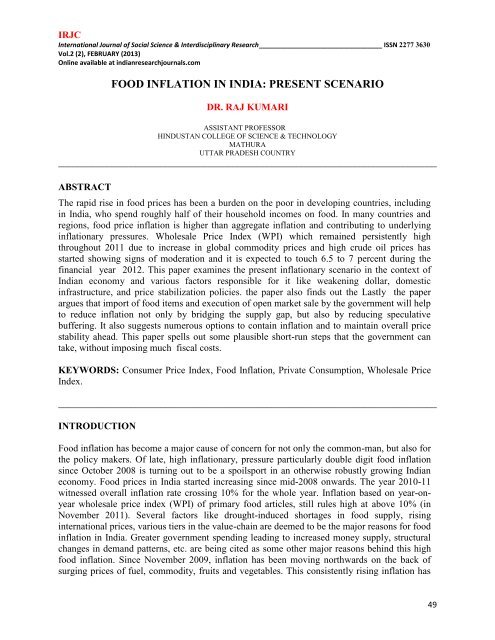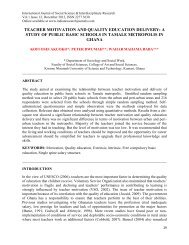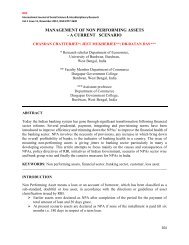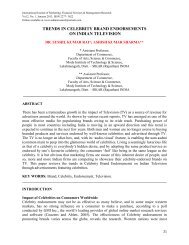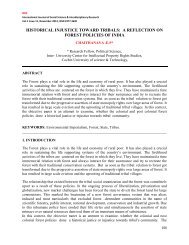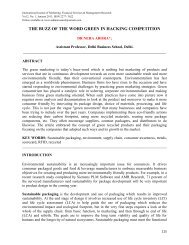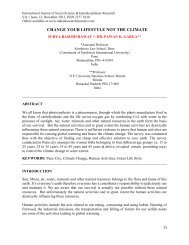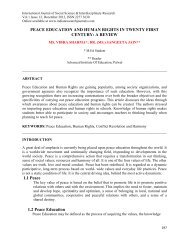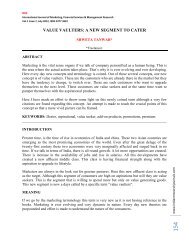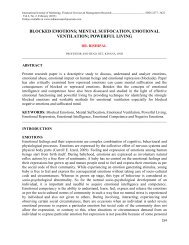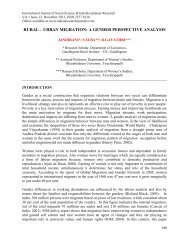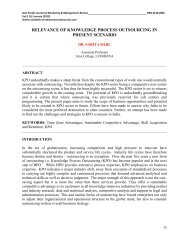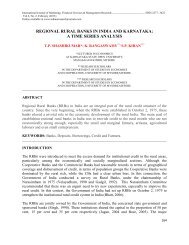food inflation in india: present scenario - indian research journals
food inflation in india: present scenario - indian research journals
food inflation in india: present scenario - indian research journals
You also want an ePaper? Increase the reach of your titles
YUMPU automatically turns print PDFs into web optimized ePapers that Google loves.
IRJC<br />
International Journal of Social Science & Interdiscipl<strong>in</strong>ary Research__________________________________ ISSN 2277 3630<br />
Vol.2 (2), FEBRUARY (2013)<br />
Onl<strong>in</strong>e available at <strong>in</strong>dian<strong>research</strong><strong>journals</strong>.com<br />
FOOD INFLATION IN INDIA: PRESENT SCENARIO<br />
DR. RAJ KUMARI<br />
ASSISTANT PROFESSOR<br />
HINDUSTAN COLLEGE OF SCIENCE & TECHNOLOGY<br />
MATHURA<br />
UTTAR PRADESH COUNTRY<br />
______________________________________________________________________________<br />
ABSTRACT<br />
The rapid rise <strong>in</strong> <strong>food</strong> prices has been a burden on the poor <strong>in</strong> develop<strong>in</strong>g countries, <strong>in</strong>clud<strong>in</strong>g<br />
<strong>in</strong> India, who spend roughly half of their household <strong>in</strong>comes on <strong>food</strong>. In many countries and<br />
regions, <strong>food</strong> price <strong><strong>in</strong>flation</strong> is higher than aggregate <strong><strong>in</strong>flation</strong> and contribut<strong>in</strong>g to underly<strong>in</strong>g<br />
<strong><strong>in</strong>flation</strong>ary pressures. Wholesale Price Index (WPI) which rema<strong>in</strong>ed persistently high<br />
throughout 2011 due to <strong>in</strong>crease <strong>in</strong> global commodity prices and high crude oil prices has<br />
started show<strong>in</strong>g signs of moderation and it is expected to touch 6.5 to 7 percent dur<strong>in</strong>g the<br />
f<strong>in</strong>ancial year 2012. This paper exam<strong>in</strong>es the <strong>present</strong> <strong><strong>in</strong>flation</strong>ary <strong>scenario</strong> <strong>in</strong> the context of<br />
Indian economy and various factors responsible for it like weaken<strong>in</strong>g dollar, domestic<br />
<strong>in</strong>frastructure, and price stabilization policies. the paper also f<strong>in</strong>ds out the Lastly the paper<br />
argues that import of <strong>food</strong> items and execution of open market sale by the government will help<br />
to reduce <strong><strong>in</strong>flation</strong> not only by bridg<strong>in</strong>g the supply gap, but also by reduc<strong>in</strong>g speculative<br />
buffer<strong>in</strong>g. It also suggests numerous options to conta<strong>in</strong> <strong><strong>in</strong>flation</strong> and to ma<strong>in</strong>ta<strong>in</strong> overall price<br />
stability ahead. This paper spells out some plausible short-run steps that the government can<br />
take, without impos<strong>in</strong>g much fiscal costs.<br />
KEYWORDS: Consumer Price Index, Food Inflation, Private Consumption, Wholesale Price<br />
Index.<br />
______________________________________________________________________________<br />
INTRODUCTION<br />
Food <strong><strong>in</strong>flation</strong> has become a major cause of concern for not only the common-man, but also for<br />
the policy makers. Of late, high <strong><strong>in</strong>flation</strong>ary, pressure particularly double digit <strong>food</strong> <strong><strong>in</strong>flation</strong><br />
s<strong>in</strong>ce October 2008 is turn<strong>in</strong>g out to be a spoilsport <strong>in</strong> an otherwise robustly grow<strong>in</strong>g Indian<br />
economy. Food prices <strong>in</strong> India started <strong>in</strong>creas<strong>in</strong>g s<strong>in</strong>ce mid-2008 onwards. The year 2010-11<br />
witnessed overall <strong><strong>in</strong>flation</strong> rate cross<strong>in</strong>g 10% for the whole year. Inflation based on year-onyear<br />
wholesale price <strong>in</strong>dex (WPI) of primary <strong>food</strong> articles, still rules high at above 10% (<strong>in</strong><br />
November 2011). Several factors like drought-<strong>in</strong>duced shortages <strong>in</strong> <strong>food</strong> supply, ris<strong>in</strong>g<br />
<strong>in</strong>ternational prices, various tiers <strong>in</strong> the value-cha<strong>in</strong> are deemed to be the major reasons for <strong>food</strong><br />
<strong><strong>in</strong>flation</strong> <strong>in</strong> India. Greater government spend<strong>in</strong>g lead<strong>in</strong>g to <strong>in</strong>creased money supply, structural<br />
changes <strong>in</strong> demand patterns, etc. are be<strong>in</strong>g cited as some other major reasons beh<strong>in</strong>d this high<br />
<strong>food</strong> <strong><strong>in</strong>flation</strong>. S<strong>in</strong>ce November 2009, <strong><strong>in</strong>flation</strong> has been mov<strong>in</strong>g northwards on the back of<br />
surg<strong>in</strong>g prices of fuel, commodity, fruits and vegetables. This consistently ris<strong>in</strong>g <strong><strong>in</strong>flation</strong> has<br />
49
IRJC<br />
International Journal of Social Science & Interdiscipl<strong>in</strong>ary Research__________________________________ ISSN 2277 3630<br />
Vol.2 (2), FEBRUARY (2013)<br />
Onl<strong>in</strong>e available at <strong>in</strong>dian<strong>research</strong><strong>journals</strong>.com<br />
resulted <strong>in</strong> a grow<strong>in</strong>g concern among policy makers, <strong>in</strong>dustry capta<strong>in</strong>s, bankers as well as the<br />
common man. Dur<strong>in</strong>g January, 2012, <strong><strong>in</strong>flation</strong> shot through the roof of touch an 11 year high of<br />
17.9%. The calendar year 2011 also saw <strong><strong>in</strong>flation</strong> at a negative rate, ironically, <strong>food</strong> <strong><strong>in</strong>flation</strong><br />
roar<strong>in</strong>g to its maximum level. The wholesale <strong>food</strong> prices <strong>in</strong> India touched a 10 year high with<br />
<strong>food</strong> <strong><strong>in</strong>flation</strong> com<strong>in</strong>g at 18.21% for the week ended March 25, 2012. This paper re<strong>present</strong>s the<br />
<strong><strong>in</strong>flation</strong>ary <strong>scenario</strong> for overall <strong>food</strong> products dur<strong>in</strong>g the year 2011-12 with the major causes,<br />
impact and measures taken by Indian government to conta<strong>in</strong> <strong>food</strong> <strong><strong>in</strong>flation</strong>.<br />
WHOLESALE PRICE INDEX (WPI)<br />
It was <strong>in</strong>troduced <strong>in</strong> the year 1907, which is calculated on the basis of average rate of change <strong>in</strong><br />
the wholesale market. A set of 435 commodities are used for wholesale price Index based<br />
<strong><strong>in</strong>flation</strong> calculations. The base year for WPI calculation is 1993-94. It is available at the end of<br />
every week (generally Friday) for a period of one year.<br />
The Government will adopt revised WPI besides consider<strong>in</strong>g actual prices. Instead of current<br />
435 commodities, the revised WPI will have 980 commodities <strong>in</strong>cluded <strong>in</strong> it. This will be<br />
rationalized by <strong>in</strong>corporat<strong>in</strong>g new items, remov<strong>in</strong>g unimportant items and amalgamat<strong>in</strong>g<br />
similar items. The base year will be revised to 2004-05 from the current base year of 1993-94.<br />
This new wholesale price <strong>in</strong>dex would give a more accurate figure for <strong><strong>in</strong>flation</strong>.<br />
CONSUMER PRICE INDEX (CPI)<br />
The WPI based <strong><strong>in</strong>flation</strong> rate, which is measured on po<strong>in</strong>t-to-po<strong>in</strong>t basis, is somewhat different<br />
from that of CPI based <strong><strong>in</strong>flation</strong>. It is a statistical time series value based on the weighted<br />
average rate of change <strong>in</strong> prices of a set of goods and services purchased by consumer. CPI is<br />
more comprehensive and it catches the <strong><strong>in</strong>flation</strong> value from the end consumer side rather than<br />
from wholesale side. CPI is based on monthly basis. India uses CPI, which most developed<br />
countries use CPI calculations for <strong><strong>in</strong>flation</strong> rate.<br />
Prices of set of 435 commodities especially Pulses, rice fruits and vegetable are used to<br />
calculate WPI <strong>in</strong> India. Economists say that India should adopt CPI for <strong><strong>in</strong>flation</strong> calculation as<br />
it is the one that shows price rise that end consumers would experience. The f<strong>in</strong>ance m<strong>in</strong>ister<br />
counts it say<strong>in</strong>g that <strong>in</strong> India there are four commodity price <strong>in</strong>dices.<br />
CPI for Industrial workers<br />
CPI for urban non manual employees<br />
CPI for Agricultural laborers<br />
CPI for Rural laborers<br />
In existence which makes switch<strong>in</strong>g over to CPI risky and complex and also CPI has too much<br />
time lag <strong>in</strong> report<strong>in</strong>g. CPI are the prices that people actually pay is fairly soft.<br />
FOOD INFLATION IN INDIA: RECENT TRENDS<br />
The table below gives the retail prices for some of the key agricultural commodities <strong>in</strong> four<br />
Indian metros. This is just to give an idea of how the prices have moved <strong>in</strong> the last one year.<br />
Clearly, the prices of all key agricultural commodities have risen sharply. Significant price<br />
<strong>in</strong>crease has been observed <strong>in</strong> commodities like, Onion, Vegetables and Fruits.<br />
50
IRJC<br />
International Journal of Social Science & Interdiscipl<strong>in</strong>ary Research__________________________________ ISSN 2277 3630<br />
Vol.2 (2), FEBRUARY (2013)<br />
Onl<strong>in</strong>e available at <strong>in</strong>dian<strong>research</strong><strong>journals</strong>.com<br />
S.<br />
No.<br />
Source: Self Compiled<br />
Table 1.1: Food Inflation for Select Commodities <strong>in</strong> 2011-12:<br />
Commodities Inflation (Percentage)<br />
1 Onions 74.15<br />
2 Vegetables 65.39<br />
3 Fruits 15.19<br />
4 Milk 12.16<br />
5 Eggs, Meat and Fish 12.04<br />
6 Rice 02.86<br />
7 Cereals 0.23<br />
8 Potatoes (-) 2.94<br />
9 Wheat (-) 6.11<br />
The key reason cited for the spiral<strong>in</strong>g <strong>food</strong> price <strong><strong>in</strong>flation</strong> is the bad monsoon <strong>in</strong> India.<br />
Monsoons have a major impact on the price levels <strong>in</strong> the country. The primary articles <strong><strong>in</strong>flation</strong><br />
orig<strong>in</strong>ates <strong>in</strong> commodities whose production is affected by the monsoon like <strong>food</strong> or cash<br />
crops. June is a critical month for all, Government leaders, bureaucrats, economists, policy<br />
makers, <strong>in</strong>dustrialists, farmers and besides, millions of ord<strong>in</strong>ary Indians. Dur<strong>in</strong>g this month, the<br />
south west monsoons usually set across the country br<strong>in</strong>g<strong>in</strong>g the much needed ra<strong>in</strong>s. Last year,<br />
monsoons set <strong>in</strong> on time, but its progress was halt<strong>in</strong>g by the time the season ended around<br />
September, the country had experienced one of the worst monsoons over the 35 years. Crops<br />
withered across the country and agricultural production suffered a setback with a loss of over<br />
15 million tons of <strong>food</strong> gra<strong>in</strong>s. The Indian farmers are largely dependent on the four-month<br />
monsoon season dur<strong>in</strong>g which 80% of the year's total ra<strong>in</strong>fall takes place. The reason is that<br />
60% of the country's total cropped area is not irrigated. The Government has aga<strong>in</strong> been talk<strong>in</strong>g<br />
about <strong>in</strong>clusive growth and stress on rural India. These facts don't po<strong>in</strong>t to any mean<strong>in</strong>gful<br />
efforts to help farmers <strong>in</strong> a country where over 10,000 farmers have committed suicide over the<br />
last decade.<br />
51
IRJC<br />
International Journal of Social Science & Interdiscipl<strong>in</strong>ary Research__________________________________ ISSN 2277 3630<br />
Vol.2 (2), FEBRUARY (2013)<br />
Onl<strong>in</strong>e available at <strong>in</strong>dian<strong>research</strong><strong>journals</strong>.com<br />
Figure 1.1: Contribution to WPI Inflation by Major Groups:<br />
Source: Economic Survey 2011-12.<br />
Primary Manufactured Fuel<br />
Look<strong>in</strong>g at the weighted contribution of major product groups to WPI <strong><strong>in</strong>flation</strong> (figure 1.1), it<br />
can be noticed that the largest contribution is made by manufactured products i.e. 49 per cent<br />
while primary articles and fuel has contributed to Wholesale Price Index only by 28 per cent<br />
and 23 percent simultaneously dur<strong>in</strong>g the year 2011-12.<br />
52
IRJC<br />
International Journal of Social Science & Interdiscipl<strong>in</strong>ary Research__________________________________ ISSN 2277 3630<br />
Vol.2 (2), FEBRUARY (2013)<br />
Onl<strong>in</strong>e available at <strong>in</strong>dian<strong>research</strong><strong>journals</strong>.com<br />
Table 1.2: WPI-based Year-on-Year Inflation <strong>in</strong> Major Subgroups:<br />
Source: Economic Survey 2011-12<br />
The <strong>food</strong> price <strong>in</strong>dex consists of ma<strong>in</strong>ly two subcomponents, namely primary <strong>food</strong> articles and<br />
manufactured <strong>food</strong> products. The overall weight of the composite <strong>food</strong> <strong>in</strong>dex <strong>in</strong> the WPI is<br />
24.31 per cent, (primary <strong>food</strong> articles: 14.34 per cent and manufactured <strong>food</strong> products: 9.97 per<br />
cent). The primary <strong>food</strong> article <strong><strong>in</strong>flation</strong> has been a cause of serious concern for the economy<br />
dur<strong>in</strong>g 2009-11. It rema<strong>in</strong>ed at an average level of 16.75 per cent <strong>in</strong> 2010-11 and 15.27 per cent<br />
<strong>in</strong> 2009-10 (April-January) ma<strong>in</strong>ly due to surge <strong>in</strong> the prices of fruits & vegetables prices and<br />
prote<strong>in</strong>-rich items such as milk, eggs, fish, and meat. However, <strong>in</strong> the current economic year<br />
average <strong><strong>in</strong>flation</strong> <strong>in</strong> <strong>food</strong> articles has significantly decl<strong>in</strong>ed to 7.15 per cent. This was ma<strong>in</strong>ly<br />
due to sizeable drop <strong>in</strong> fruits and vegetables prices. as a result of which <strong><strong>in</strong>flation</strong> <strong>in</strong> these<br />
commodities has now turned negative <strong>in</strong> December 2011 and January 2012 (Table 1.2).<br />
53
IRJC<br />
International Journal of Social Science & Interdiscipl<strong>in</strong>ary Research__________________________________ ISSN 2277 3630<br />
Vol.2 (2), FEBRUARY (2013)<br />
Onl<strong>in</strong>e available at <strong>in</strong>dian<strong>research</strong><strong>journals</strong>.com<br />
Figure 1.2: Weighted contribution of <strong>food</strong> Items to headl<strong>in</strong>e <strong><strong>in</strong>flation</strong>:<br />
Source: Economic Survey 2011-12<br />
It is clear from the above figure 1.2 that the weighted contribution of <strong>food</strong> articles <strong>in</strong> headl<strong>in</strong>e<br />
<strong><strong>in</strong>flation</strong> has shown a fluctuat<strong>in</strong>g trend cont<strong>in</strong>uously from January 2010 to January 2012.it<br />
was 10 percent <strong>in</strong> January 2010, decl<strong>in</strong>ed up to 2 percent <strong>in</strong> May 2011 and aga<strong>in</strong> <strong>in</strong>creased up<br />
to 10 percent <strong>in</strong> January 2012. Contribution of Eggs, meat and Fish is almost constant but the<br />
overall contribution of milk has decl<strong>in</strong>ed and crossed zero and became negative dur<strong>in</strong>g Dec’<br />
2011 to Jan’ 2012. The weighted contribution of <strong>food</strong> gra<strong>in</strong>s to headl<strong>in</strong>e <strong><strong>in</strong>flation</strong> has<br />
decreased significantly from 10 percent <strong>in</strong> January 2010 to 3 percent <strong>in</strong> January 2012.<br />
MAIN DRIVERS OF FOOD INFLATION<br />
The major drivers of <strong>food</strong> <strong><strong>in</strong>flation</strong> dur<strong>in</strong>g the current f<strong>in</strong>ancial year were milk, eggs/ meat/<br />
fish, and edible oils. In comparison with last year when cereals, vegetables, and sugar were<br />
the ma<strong>in</strong> contributors to <strong>food</strong> <strong><strong>in</strong>flation</strong>, 2011-12 witnessed higher contribution from<br />
manufactured <strong>food</strong> products especially edible oils due to higher global prices of soybean oil,<br />
palm oil, etc.<br />
1. Capital Stock Deficiency: Capital stock deficiency tends to lead to bottlenecks, under which<br />
resource constra<strong>in</strong>ts, <strong>in</strong>clud<strong>in</strong>g limited <strong>in</strong>frastructure and lack of manufactur<strong>in</strong>g capacity delay<br />
overall production or service generat<strong>in</strong>g processes which leads to higher <strong><strong>in</strong>flation</strong> through<br />
shortages <strong>in</strong> supply. India's capital stock-to-GDP ratio was 1.79 <strong>in</strong> 2010, among the lowest <strong>in</strong><br />
Asia which is follow<strong>in</strong>g the same trend <strong>in</strong> the year 2012 also.<br />
2. Demand Side Drivers: Demand-side <strong><strong>in</strong>flation</strong> drivers, especially those aris<strong>in</strong>g from a sharp<br />
rise <strong>in</strong> personal disposable <strong>in</strong>come and an expansionary fiscal policy, have also played an<br />
important role <strong>in</strong> keep<strong>in</strong>g <strong><strong>in</strong>flation</strong> persistently high. As the credit policies are now liberalized<br />
54
IRJC<br />
International Journal of Social Science & Interdiscipl<strong>in</strong>ary Research__________________________________ ISSN 2277 3630<br />
Vol.2 (2), FEBRUARY (2013)<br />
Onl<strong>in</strong>e available at <strong>in</strong>dian<strong>research</strong><strong>journals</strong>.com<br />
more money is <strong>in</strong>jected <strong>in</strong>to the economy which is <strong>in</strong>creas<strong>in</strong>g the purchas<strong>in</strong>g power of the<br />
people the key reason to <strong>in</strong>duce demand.<br />
3. Food Price Pressures: Food price <strong><strong>in</strong>flation</strong> has been a major driver of <strong><strong>in</strong>flation</strong> dur<strong>in</strong>g the year<br />
2011-2012, because lack of ra<strong>in</strong>fall dur<strong>in</strong>g the monsoon season often hits India's <strong>food</strong><br />
production. In addition, the structural change <strong>in</strong> <strong>food</strong> <strong>in</strong>take has significantly contributed to<br />
<strong>food</strong> price <strong><strong>in</strong>flation</strong> <strong>in</strong> 2011-12.<br />
4. Import Price Pressures: Import price pressures have also been an important factor for overall<br />
<strong><strong>in</strong>flation</strong> as India has become a more open economy over the past 10 years. In fact, the<br />
imported goods-to-GDP ratio doubled from just above 11 percent <strong>in</strong> the f<strong>in</strong>ancial year 2000-<br />
01 to 21.9 percent <strong>in</strong> F<strong>in</strong>ancial Year 2010-11 with bulk imports, such as crude oil, metals,<br />
rubber and <strong>food</strong> articles account for 42.7 percent of total imports.<br />
5. Inflation Expectations: In the RBI's latest <strong><strong>in</strong>flation</strong> expectations survey of households,<br />
respondents' <strong><strong>in</strong>flation</strong> expectations for three months ahead <strong>in</strong>ched up to 12.2 percent <strong>in</strong> the<br />
third quarter of 2011 from 11.8 percent <strong>in</strong> the second quarter. Overall, <strong><strong>in</strong>flation</strong> expectations<br />
have been largely driven by <strong>food</strong> price <strong><strong>in</strong>flation</strong> <strong>in</strong> India as <strong>food</strong> constitutes more than 50<br />
percent of the average Indian household's consumption basket. WPI <strong>food</strong> <strong><strong>in</strong>flation</strong> dropped<br />
from 20.2% <strong>in</strong> February 2010 to 1.6% <strong>in</strong> January 2012, calibrated steps <strong>in</strong>itiated to re<strong>in</strong>-<strong>in</strong><br />
<strong><strong>in</strong>flation</strong> on top priority.<br />
6. Other Factors: The <strong>food</strong> subsidy <strong>in</strong> India is poorly targeted. Many of the poor receive<br />
<strong>in</strong>significant amounts of subsidy and depend on the market to access supplies. In spite of this,<br />
a reduction <strong>in</strong> the <strong>food</strong> subsidy is not <strong>in</strong> their <strong>in</strong>terest as the reduction <strong>in</strong> subsidy <strong>in</strong>creases the<br />
market price of <strong>food</strong>. The <strong>in</strong>efficient storage and mal-function<strong>in</strong>g of Public Distribution<br />
System has also led to <strong><strong>in</strong>flation</strong> of <strong>food</strong> commodities.<br />
OPTIONS TO ENSURE PRICE STABILITY IN FOOD ITEMS<br />
The per-hectare agricultural yield <strong>in</strong> India is half that of Ch<strong>in</strong>a. This aga<strong>in</strong> po<strong>in</strong>ts of<br />
<strong>in</strong>efficiency and the failure to help the farmers adopt latest technology <strong>in</strong> order to <strong>in</strong>crease the<br />
crop output. These th<strong>in</strong>gs have not been taken care of <strong>in</strong> the past and even when discussed<br />
noth<strong>in</strong>g substantial has been done <strong>in</strong> order to overcome these challenges. Steps are to be taken<br />
<strong>in</strong> the near future to ensure m<strong>in</strong>imal <strong>food</strong> wastage, high crop productivity and <strong>in</strong>crease <strong>in</strong><br />
irrigated land. If the INR 58,000 crore of <strong>food</strong> crops is not wasted on an annual basis, India's<br />
deficits could be wiped out <strong>in</strong> less then a decade without any other measures be<strong>in</strong>g taken.<br />
However, look<strong>in</strong>g <strong>in</strong>to the very near term, some ways to ease <strong>food</strong> prices would be:<br />
Another major related issue is the strengthen<strong>in</strong>g of the supply cha<strong>in</strong> so as to avoid wastage of<br />
perishable products. One suggestive measure <strong>in</strong> this regard could be the expeditious<br />
completion of the Agriculture Produce Market<strong>in</strong>g Committee (APMC) Acts reforms <strong>in</strong><br />
different states so that enough flexibility is imparted to farmers to sell their produce. Further,<br />
it is important to develop a robust agricultural market<strong>in</strong>g system through adequate <strong>in</strong>vestment<br />
- domestic and/or foreign - so as to strengthen the back end <strong>in</strong>frastructure and reduce<br />
wastages.<br />
For promot<strong>in</strong>g <strong>in</strong>terstate trade, a commodity for which market fee has been paid once must not<br />
be subjected to subsequent market fee <strong>in</strong> other markets <strong>in</strong>clud<strong>in</strong>g that for transaction <strong>in</strong> other<br />
55
IRJC<br />
International Journal of Social Science & Interdiscipl<strong>in</strong>ary Research__________________________________ ISSN 2277 3630<br />
Vol.2 (2), FEBRUARY (2013)<br />
Onl<strong>in</strong>e available at <strong>in</strong>dian<strong>research</strong><strong>journals</strong>.com<br />
states. Only user charges l<strong>in</strong>ked to services provided may be levied for subsequent<br />
transactions.<br />
Perishable <strong>food</strong> items could be taken out of ambit of the APMC Act. The Government<br />
regulatory markets sometimes prevent retailers from <strong>in</strong>tegrat<strong>in</strong>g their enterprises with those of<br />
farmers. In view of this perishable may have to be exempted from this regulation.<br />
To arrest the adverse impact of <strong>food</strong> <strong><strong>in</strong>flation</strong> on the common man, the policy of the<br />
government should emphasis on the PDS, foreign trade policy, and distribution of essential<br />
commodities at below market prices through state public-sector units (PSUs), anti-hoard<strong>in</strong>g<br />
operations, and strengthen<strong>in</strong>g of supply cha<strong>in</strong> efficiency.<br />
As a strategy, regular imports of agriculture commodities <strong>in</strong> relatively smaller quantities with<br />
an upper ceil<strong>in</strong>g on total quantity could be considered. The upper ceil<strong>in</strong>g can be decided<br />
annually, relatively well <strong>in</strong> advance, after assess<strong>in</strong>g the likely domestic situation <strong>in</strong> terms of<br />
production and consumption requirements.<br />
Extension programmes and guidance to farmers regard<strong>in</strong>g fertilizer and <strong>in</strong>secticide uses an<br />
alternate cropp<strong>in</strong>g pattern based on soil analysis could be undertaken and <strong>in</strong>tensified.<br />
In view of the relatively high weight of <strong>food</strong> <strong>in</strong> the CPI, agricultural shocks not only <strong>in</strong>crease<br />
short-run <strong><strong>in</strong>flation</strong>, but also can generate a susta<strong>in</strong>ed <strong>in</strong>crease <strong>in</strong> the <strong><strong>in</strong>flation</strong> rate if it raises<br />
<strong><strong>in</strong>flation</strong>ary expectations. As a consequence, India should endeavor to liberalize agriculture to<br />
reduce the volatility of <strong>food</strong> prices and such an endeavor is Evergreen Revolution.<br />
Any strategy for strengthen<strong>in</strong>g agricultural market<strong>in</strong>g needs to have a three-pronged objective:<br />
first, of provid<strong>in</strong>g remunerative prices to farmers; second, strengthen<strong>in</strong>g efficiencies of supply<br />
cha<strong>in</strong>; and third, ensur<strong>in</strong>g that end consumers are charged fair and reasonable prices.<br />
Sett<strong>in</strong>g up special markets for special crops <strong>in</strong> states/regions/areas produc<strong>in</strong>g those crops would<br />
facilitate supply of superior commodities to the consumers.<br />
Improved Mandi governance is an area of concern. A greater number of traders must be<br />
allowed as agents <strong>in</strong> markets. Anyone who gets better prices and terms outside the<br />
Agricultural Produce Market<strong>in</strong>g Committee (APMC) or its farm gate should be allowed to do<br />
so.<br />
Consider<strong>in</strong>g significant <strong>in</strong>vestment gaps <strong>in</strong> post harvest <strong>in</strong>frastructure of agriculture produce,<br />
organized trade and agriculture should be encouraged and the FDI <strong>in</strong> multi brand reta<strong>in</strong> once<br />
implemented could be effectively leveraged towards this end.<br />
The Government should step up creation of modern stories facilities for <strong>food</strong> gra<strong>in</strong>s.<br />
Crackdown on hoarders and black marketers could help prevent prices from ris<strong>in</strong>g further. This<br />
step might not significantly reduce prices but will ensure that prices don't escalate further.<br />
The Government should allow the private sector to import and store the primary agricultural<br />
commodities at zero import duty. This will help ease the prices to a large extent.<br />
The Government also needs to unload the wheat <strong>in</strong>ventory it has <strong>in</strong> its storage locations. This<br />
will have an immediate impact on the prices<br />
56
IRJC<br />
International Journal of Social Science & Interdiscipl<strong>in</strong>ary Research__________________________________ ISSN 2277 3630<br />
Vol.2 (2), FEBRUARY (2013)<br />
Onl<strong>in</strong>e available at <strong>in</strong>dian<strong>research</strong><strong>journals</strong>.com<br />
CONCLUSION<br />
Ma<strong>in</strong>ta<strong>in</strong><strong>in</strong>g low <strong><strong>in</strong>flation</strong> and push<strong>in</strong>g growth <strong>in</strong> the short run is, however, often a knife-edge<br />
problem. The price of a good <strong>in</strong> a free market should be determ<strong>in</strong>ed by its relative scarcity, i.e.<br />
supply relative to demand. But <strong>in</strong> a high-<strong><strong>in</strong>flation</strong> environment, relative price shifts may not<br />
reflect underly<strong>in</strong>g demand-supply conditions of different goods and services. As a result,<br />
dispersion <strong>in</strong> relative price <strong>in</strong>creases lead to distortion <strong>in</strong> price signals. High <strong><strong>in</strong>flation</strong> has<br />
adverse impact on growth through a variety of channels. First, high <strong><strong>in</strong>flation</strong> leads to<br />
uncerta<strong>in</strong>ty which impacts <strong>in</strong>vestment and growth. As it is, <strong>in</strong>vestment decisions are subject to<br />
a lot of uncerta<strong>in</strong>ties. High and volatile <strong><strong>in</strong>flation</strong> adds to these uncerta<strong>in</strong>ties. Second, high<br />
<strong><strong>in</strong>flation</strong> results <strong>in</strong> movement of sav<strong>in</strong>gs from f<strong>in</strong>ancial assets to physical and other<br />
unproductive activities. Therefore, low and stable <strong><strong>in</strong>flation</strong> is desirable from a number of<br />
perspectives. In that context, for monetary policy to be effective it is vital for central banks and<br />
macroeconomic policymakers to have reasonable forward-look<strong>in</strong>g short-term forecasts of<br />
<strong><strong>in</strong>flation</strong> on which to base decisions. The government monitors the price situation regularly as<br />
price stability rema<strong>in</strong>s high on its agenda. Measures taken to conta<strong>in</strong> prices of essential<br />
commodities <strong>in</strong>clude selective ban on exports and futures trad<strong>in</strong>g <strong>in</strong> <strong>food</strong> gra<strong>in</strong>s, zero import<br />
duty on select <strong>food</strong> items, permitt<strong>in</strong>g import of pulses and sugar by PSUs, distribution of<br />
imported pulses and edible oils through the PDS, and release of higher quota of non-levy sugar.<br />
In addition, state governments are empowered to act aga<strong>in</strong>st hoarders of <strong>food</strong> items by hold<strong>in</strong>g<br />
<strong>in</strong> abeyance the removal of restrictions on licens<strong>in</strong>g, stock limits, and movement of <strong>food</strong><br />
articles under the Essential Commodities Act 1955. The hike <strong>in</strong> policy rates by the RBI was due<br />
to persistently high <strong><strong>in</strong>flation</strong>. The high rates, however, have impacted growth <strong>in</strong> the short run.<br />
There is need to exam<strong>in</strong>e the l<strong>in</strong>kages and tradeoffs between policy rate changes and growth <strong>in</strong><br />
the Indian context. Such understand<strong>in</strong>g is important for better calibration of monetary policy<br />
both with respect to size and tim<strong>in</strong>g of rate changes. This is especially important s<strong>in</strong>ce<br />
monetary policy primarily addresses demand-side factors relevant for <strong><strong>in</strong>flation</strong> management<br />
whereas supply-side factors also play a key role <strong>in</strong> contribut<strong>in</strong>g to susta<strong>in</strong>ed <strong>in</strong>crease <strong>in</strong> prices.<br />
Renewed attention to structural ways of improv<strong>in</strong>g medium-term supply responses <strong>in</strong><br />
agriculture and supply cha<strong>in</strong>s and <strong>in</strong>frastructure more broadly may be vital. Moreover, The<br />
Evergreen Revolution of boost<strong>in</strong>g <strong>food</strong>-gra<strong>in</strong> output <strong>in</strong> India to 400 million tons <strong>in</strong> next 15<br />
years is need of the day. Its achiev<strong>in</strong>g is not very difficult. Rather it is achievable if m<strong>in</strong>dset on<br />
<strong>in</strong>troduc<strong>in</strong>g newer technology is changed. India has to whole-heartedly embrace the new<br />
technology. Private sector is better suited to deliver results than government managed schemes.<br />
Governments on the other hand can play a key role <strong>in</strong> expedit<strong>in</strong>g irrigation schemes and<br />
manag<strong>in</strong>g water resources.<br />
57
IRJC<br />
International Journal of Social Science & Interdiscipl<strong>in</strong>ary Research__________________________________ ISSN 2277 3630<br />
Vol.2 (2), FEBRUARY (2013)<br />
Onl<strong>in</strong>e available at <strong>in</strong>dian<strong>research</strong><strong>journals</strong>.com<br />
REFERENCES<br />
1. Chand, R. Gulati,Ashok . Sh<strong>in</strong>oj P. Ganguly, Kavery. (2011). Manag<strong>in</strong>g Food Inflation <strong>in</strong><br />
India: Reforms and Policy Options. NCAP Policy Brief.<br />
2. Jais<strong>in</strong>ghani, Bella (2010, August 29). Inflation Weighs Heavy on Feast and Fasts. Sunday<br />
Time Editorial.<br />
3. Khalid Aowte Yasmeen (2011). Food Inflation <strong>in</strong> Indi. International Conference on<br />
Information and F<strong>in</strong>ance. IPEDR vol.21.<br />
4. Lamm, McFall. R. (1979). Dynamics of Food Price Inflation. Western Journal of Agricultural<br />
Economics. Vol. 4,<br />
5. S<strong>in</strong>gh, Sumanjeet. (2009). Global <strong>food</strong> crisis: magnitude, causes and policy measures.<br />
International Journal of Social Economics. Vol. 36.<br />
6. Sunday Times (2010, September 16). Ris<strong>in</strong>g Food Prices. Times of India Editorial.<br />
7. Highlights of Economic Survey. 2011-12.<br />
8. http://www.eastasiaforum.com.<br />
9. http://www.worldjute.com/<strong><strong>in</strong>flation</strong>.html<br />
10. www.trad<strong>in</strong>geconomics.com/economics/<strong><strong>in</strong>flation</strong><br />
11. www.igovernment.<strong>in</strong>/site<br />
58


